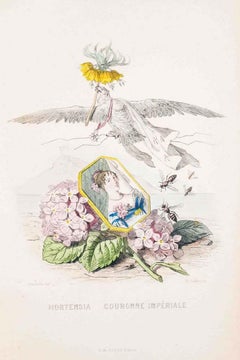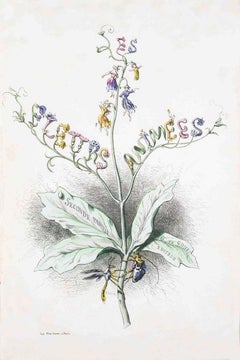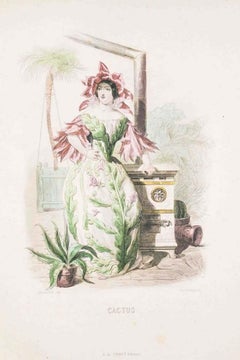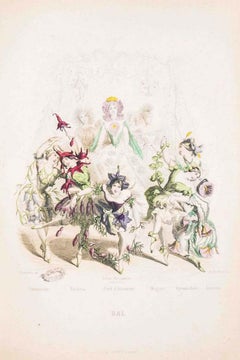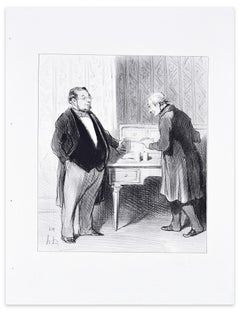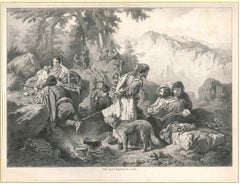1840s Art
to
35
607
293
45
18
14
Overall Width
to
Overall Height
to
7,478
21,067
160,093
233,327
1,940
2,227
4,772
6,398
5,824
14,944
20,283
25,512
17,770
13,649
5,305
702
13
7
1
1
621
347
4
641
290
242
194
132
127
101
93
84
62
61
48
43
40
31
31
27
27
24
24
670
128
114
78
63
40
38
27
15
8
123
707
744
145
Period: 1840s
Hortensia Couronne Impériale - Les Fleurs - Lithograph by J.J. Grandville - 1847
Located in Roma, IT
Image dimensions: 24.3 x 17.5 cm.
Single sheet with passepartout.
"...The unhappy man had approached that mysterious spot where, amid a thousand aquatic plants, the Water-arrow gr...
Category
Modern 1840s Art
Materials
Lithograph
Frontispiece - Les Fleurs Animées Vol.II - Lithograph by J.J. Grandville - 1847
Located in Roma, IT
Image dimensions: 24.3 x 17.5 cm.
Single sheet with passepartout.
"At a crossing in the forest, where four roads unite, a number of flowers happened to meet - among which were seen the Cactus, the Peach-blossom, the Dahlia, the Sensitive-plant, the Fuchsia, the Periwinkle, and the Sweet-scented Pea." T. Delord.
Les Fleurs animées...
Category
Modern 1840s Art
Materials
Lithograph
Cactus - Les Fleurs Animées Vol.II - Lithograph by J.J. Grandville - 1847
Located in Roma, IT
Image dimensions: 24.3 x 17.5 cm.
Single sheet with passepartout.
"...The entire history of my life on earth may be summed up in four words - I have been cold." T. Delord.
Les Fl...
Category
Modern 1840s Art
Materials
Lithograph
Bal - Les Fleurs Animées Vol.II - Lithograph by J.J. Grandville - 1847
Located in Roma, IT
Image dimensions: 24.3 x 17.5 cm.
Single sheet with passepartout.
"Delighted at finding themselves again united, after all theit vicissitudes, the chief flowers determined on givi...
Category
Modern 1840s Art
Materials
Lithograph
Monsieur Par suite De La Fusion... - Lithograph by H. Daumier - 1845
Located in Roma, IT
Image dimensions: 23 x 19 cm.
Monsieur Par suite De La Fusion... - From “Les philanthropes du jour” is an original artwork realized by Honoré Daumier in 1845/46.
Original complete ...
Category
Modern 1840s Art
Materials
Lithograph
Salvator Rosa at the Brigands - Original Litho by A.P. Riffaut After Guignot
Located in Roma, IT
Salvator Rosa at the Brigands is an original artwork realized by Adolphe Pierre Riffaut in 1844. Original lithograph on paper after A. Guignot.
Artist's proof before Letter. Passepa...
Category
1840s Art
Materials
Lithograph
L'Homme in naturalibus
Located in New York, NY
Honore Daumier (1808-1879), L'Homme in naturalibus, lithograph, from the Robert Macaire 2nd series, plate number 17. Published 1840-41. In generally good condition; a tiny hole lowe...
Category
1840s Art
Materials
Lithograph
Un Homme a La Mer
Located in New York, NY
Honore Daumier (1808-1879), Un Homme a La Mer lithograph, 1843, [with initials in the plate]. Reference: Daumier Register 1036, plate number 14 from the series Les Canotiers...
Category
Realist 1840s Art
Materials
Lithograph
Original Antique Mackinnon Highlander Lithograph by Bosley 1845 Framed Print
Located in Bristol, CT
Print Sz: 12 1/2"H x 8 3/8"W
Frame Sz: 23 1/4"H x 19 1/8"W
*slight foxing condition noted*
Clan MacKinnon is a Highland Scottish clan from the islands of Mull and Skye, in the Inn...
Category
1840s Art
Materials
Lithograph
"Coin Beads--Western US Wilderness Expedition, " Color Lithograph by Seth Eastman
By Seth Eastman
Located in Milwaukee, WI
"Coin Beads - Western US Wilderness Expedition of 1847" is a color lithograph by Seth Eastman. It depicts various Native American beads used as currency and...
Category
1840s Art
Materials
Lithograph
Facade of the Pronaos of the Temple of Edfou - David Roberts - orientalist
Located in London, GB
David Roberts
1796 - 1864
Facade of the Pronaos of the Temple of Edfou
First Edition lithograph
Full plate: 208
Presented in a acid free mount
We have all 250 of the Lithograph set...
Category
1840s Art
Materials
Lithograph
A Study for the Angel of Saint-Severin church in Paris, by Paul Flandrin
Located in PARIS, FR
After the restoration of the Saint-John chapel’s frescoes at the Saint-Severin church in Paris in 2022, the drawing presented here is a moving testimony to their creative process. It...
Category
Old Masters 1840s Art
Materials
Chalk
Yoshikazu Utagawa - Yoshinaka and the Shitenno Confront a Serpent at Okuyama
By Yoshikazu Utagawa
Located in BRUCE, ACT
Yoshikazu Utagawa (active circa 1850 - 1870)
Yoshinaka and the Shitenno Confront a Serpent at Okuyama
This is the middle panel of three
c. 1844 - 1848
Oban
Good impression and ...
Category
1840s Art
Materials
Woodcut
Large Victorian coastal marine painting by Edward William Cooke, R.A.
Located in London, GB
Large Victorian coastal marine painting by Edward William Cooke, R.A.
English, 1842
Frame: height 92cm, width 128cm, depth 6.5cm
Canvas: height 77cm, width 122cm
This superb marine ...
Category
Romantic 1840s Art
Materials
Canvas, Oil
"Live-Bait Fishing for Jack" by James Pollard
Located in Bristol, CT
Classic hand-coloured litho by James Pollard (1792-1867) entitled "Live Bait Fishing For Jack" dedicated to the 'Members of the Waltonian Society, by a Br...
Category
1840s Art
Materials
Lithograph
Framed English Portrait w/ c1848 1 Penny Postage Stamp/ Envelope
Located in Bristol, CT
Envelope Sz: 4 3/4"H x 4"W
Frame Sz: 11 3/4"H x 14 3/4"W
w/ leaf gilt frame
Category
1840s Art
Materials
Paper
Self-portrait
Located in PARIS, FR
Self-portrait
"Fratin by himself"
by Christophe FRATIN (1801-1864)
Bronze with nuanced dark brown patina
Signed on the base "Fratin"
Raised on a wooden base, with an old collector s...
Category
French School 1840s Art
Materials
Bronze
"Galantes Paar" by Henri Druard - Oil on Canvas - 100x81 cm
Located in Geneva, CH
Artwork sold with frame (100 x 120 x 7.5 cm)
Henri Druard (1821–1877) was a French painter known for his genre scenes and depictions of everyday life in 19th-century France. Born in...
Category
Realist 1840s Art
Materials
Canvas, Oil
"Hawthorn, Whitethorn - Mespilus Oxycantha"
Located in Lambertville, NJ
Ashley John is proud to offer this artwork by:
Emily Stackhouse (1811 - 1870)
Miss Emily Stackhouse was born in the West Country in 1811, the same year as botanist and writer Reve...
Category
Realist 1840s Art
Materials
Paper, Watercolor
The Jolly Flat Boat Men
By George Caleb Bingham
Located in Missouri, MO
The Jolly Flat Boat Men, 1847
After George Caleb Bingham (American, 1811-1879)
Engraved by Thomas Doney (French, active New York 1844-1849)
Engraving with Hand-Coloring
Published by The American Art-Union, New York (1838-1851)
Printed by Powell and Co.
18 x 24 inches
32 x 38 inches with frame
In 1847, the American Art-Union purchased Bingham’s painting "The Jolly Flat Boat Men" (1846; National Gallery of Art) directly from the artist. The subscription-based organization, founded in 1838 as the Apollo Association, boasted nearly ten-thousand members at this date. For an annual fee of five dollars, each received a large reproductive engraving and was entered in a lottery to win original artworks exhibited at the Art-Union’s Free Gallery. Aimed at educating the public about contemporary American art, the organization developed an impressive distribution network that reached members in every state. The broad circulation of the Art-Union's print helped to establish Bingham's reputation and made his river scene famous.
Born in Augusta County, Virginia in the Shenandoah River Valley, George Caleb Bingham became known for classically rendered western genre, especially Missouri and Mississippi River scenes of boatmen bringing cargo to the American West and politicians seeking to influence frontier life. One of his most famous river genre paintings was The Jolly Flatboatmen completed in several versions in 1846. This first version of this painting is in the Manoogian Collection at the National Gallery of Art. Fame resulted for this work when it was exhibited in New York at the American Art Union whose organizers made an engraving of 10,000 copies and distributed it to all of their members. Paintings such as Country Politician (1849) and County Election (1852) and Stump Speaking (1854) reflected Bingham's political interests.
In 1819, as an eight-year old, he moved to Boon's Lick, Missouri with his parents and grandfather who had been farmers and inn keepers in the Shenandoah Valley near Rockingham, Virginia. Reportedly as a child there, he took every opportunity to escape supervision to travel the River and watch the marine activity.
His father died in 1827, when his son was sixteen years old. His mother had encouraged his art talent, but art lessons were not easily obtainable. In order to earn money, he apprenticed to a cabinet maker but determined to become an artist. By 1835, he had a modest reputation as a frontier painter and successfully charged twenty dollars per portrait in St. Louis. "His portraits had become standard decorations in prosperous Missouri homes." (Samuels 46). In 1836, he moved to Natchez, Mississippi and there had the same kind of career, only was able to charge forty dollars per portrait.
He remained largely self taught until 1837, when he, age 26 and using the proceeds from his portraiture, studied several months at the Pennsylvania Academy of the Fine Arts. He later said that he learned much of his atmospheric style and classically balanced composition by copying paintings in collections in St. Louis and Philadelphia and that among his most admired painters were Thomas Cole, John Vanderlyn, and William Sidney Mount. Between 1856 and 1859, Bingham traveled back and forth to Dusseldorf, Germany, where he studied the work of genre painters. Some critics think these influences were negative on his work because during that time period, he abandoned his luminist style that had brought him so much public affirmation.
Bingham credited Chester Harding (1792-1866) as being the earliest and one of the most lasting influences on his work. Harding,a leading portraitists when Bingham was a young man, had a studio in Franklin, near Bingham's home town. In 1822, when Bingham was ten years old, he watched Harding finish a portrait of Daniel Boone. Bingham recalled that watching Harding with the Boone portrait was a lasting inspiration and that it was the first time he had ever seen a painting in progress. Harding suggested to Bingham that he begin doing portraiture by finding subjects in the river men, which, of course, opened the subject matter that established fame and financial success for Bingham. Harding also encouraged Bingham to copy with paint engravings. He later painted two portraits of Boone but, contrary to the assertions of some scholars, he did not do Boone portraits in the company of Harding.
Bingham's portraits of Boone are not located, but one of them, a wood signboard for a hotel in Boonville circa 1828 to 1830, showed a likeness of Boone in buckskin dress...
Category
Hudson River School 1840s Art
Materials
Engraving
Price Upon Request
